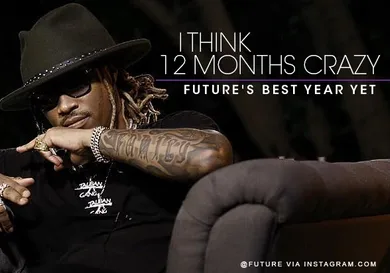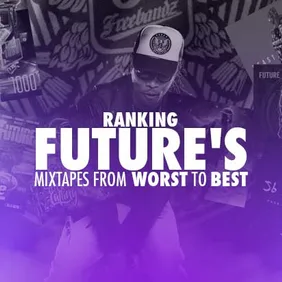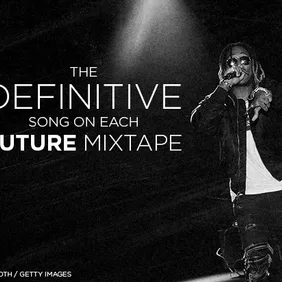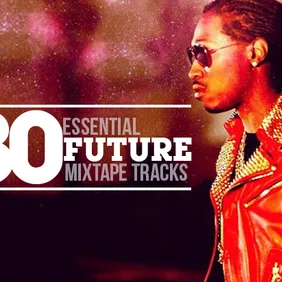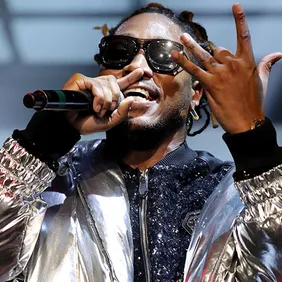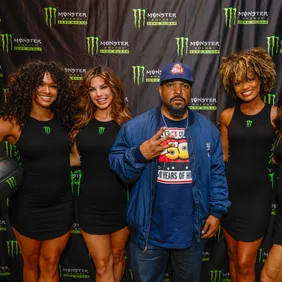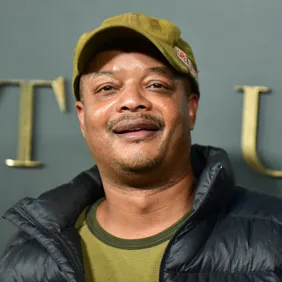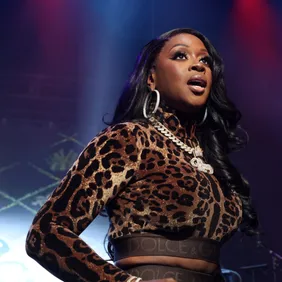"Dis for the ones that abandoned me," Future wrote on Instagram one year ago today, hours after releasing his mixtape Monster. Three days prior, on Ciara's birthday, he posted one reading "I was there but mentally I was somewhere else." At first glance, both of these moody captions seemed directed at his ex-fiancé, with whom he'd split up in August 2014, but looking back on them a year later, they also seem to hold deeper truths about his career. Monster marked the start of a new era for Future, one where he regained full artistic control over his music, successfully channelled his trials and tribulations, and took the game by storm, eclipsing the hype and commercial peaks of his initial 2011-2012 hot streak. With that tape, he set off on an interstellar trajectory, and is still seemingly in the ascent portion of his journey 12 months later. Today, we look back on his massive year.
Future's sophomore album, Honest, was released six months prior to Monster, and contrary to the narrative adopted by many (Future included), it wasn't received that poorly upon arrival. A Number 2 debut on the charts and an aggregate score of 80 on Metacritic is by no means a failure, but the album's problems lurked beneath those face-value attributes. By the time of its April release, Honest had been delayed by Future's label (Epic) for months, usually a sign that they weren't happy with earlier versions of it. Guests and a mixed-bag collection of producers littered the album, the presence of some (such as Kanye, Pharrell, and Beyoncé producer Detail) hinting that Epic had played matchmaker with Future in hopes for crossover hits. Critics seemed uniformly impressed by it, but it was a different story for fans (check the disconnect on our own review of it), some of whom demanded more hits, and some of whom just hadn't come around to Future Hendrix yet. All of this, along with the messy breakup, seemed to weigh heavy on Future at that perilous point in his career-- he already had his breakout "moment," and after failing to use his first two albums as pole vaults to rap's upper echelon, he was at risk of either stagnating in middle-tier stardom or seeing all of his gains evaporate.
When I spoke with Southside, who had only recently met Future at the time of Honest's release, I asked him about this make-or-break moment in the rapper's career:
"Me and Metro was in Future’s ear so much. Like, ‘Yo, you’re talented. You can write for whoever or whatever, but you gotta think how you came out, my man. You came out ‘Same Damn Time,’ ‘Tony Montana,’ it’s time to get back to that.’”
The message was loud and clear: Future had tested the waters as a crossover artist capable of writing for Beyoncé and Rihanna, but he made his name with booming trap anthems, and now was the time to step back into that mode with a reinvigorated sense of purpose. He did so by embracing his demons, by treating the mainstream gauntlet he had run as a series of radioactive tests on a patient that came out the other side a depraved, substance-abusing shell of his former self. The cover of Monster shows his face semi-mummified, emerging from the bandages with an enraged howl like an out-the-mud Lurtz in "Fellowship Of The Ring." Befitting this unhinged image is a tape that's still a little unfocused and a little too lengthy, but is just savage in its unrelenting drive. The title track provides post-breakup Future's mission statement: "I'm a young gunner ain't worried about karma / I'm just livin' my life and I'ma get me some money." He had nothing to lose, the bets were all off; there was only one feature and the production came entirely from people in his ATL circle.
Anyone can make angry, "fuck the world" music though, and Monster's most revelatory moments came when Future used the melodic and emotive skills he'd picked up on his albums to convey his distress. With different words, "My Savages" could've appeared as a lovelorn ballad on Honest, but instead of doling praise on Ciara, Future pays tribute to his incarcerated friend Doe Boy, his deceased grandfather and of course, the ever-loyal DJ Esco. More stunningly, tape closer "Codeine Crazy" subverts the lean glorification that's defined so much Southern rap into a psychedelic, soul-baring opus, which peaks when Future breaks into a rarely-used falsetto and attempts to exorcise his addiction.
With one of Monster's tracks, "Fuck Up Some Commas," beginning to take on a life of its own, Future released Beast Mode in January. The nine-track release was entirely produced by Zaytoven, his shiny, more organic sound giving the tape a much brighter vibe than its predecessor's dark hues. The artwork was just as startling as Monster's though-- Future's hand, dripping in blood, clenching a microphone that has a human heart where its mouthpiece should be. Having introduced the world to the hideous, unrepentant demon that lurked underneath his skin, he now proceeded to rip out its calloused heart and let the blood spill into his lyrics. The result was... oddly enjoyable. Zay gets on a crazy tip that sounds something like Billy Joel playing spiritual hymns in Magic City, and after the best tribute to Juvenile's "Ha" this side of Clipse's "Ain't Cha," the only thing interrupting all the fun is a little voice in the back of our heads asking, "But where did all of Future's pain go?" The next track answers immediately with Future singing, "You gotta feel the pain of a kid in the ghetto."
Of all of Future's post-Honest solo projects, Beast Mode is the most light-hearted, but it still contains enough of Future's comeback narrative to count as one of the stops on his Homeric odyssey. In Greek mythology, Odysseus' tale ends with coming home to his wife, but Future's is the reverse. He got carried away into unfamiliar territory while living the celeb life with Ciara, and Monster began his quest back to his homeland as a changed, disillusioned wanderer. The last verse of "Just Like Bruddas" has Future downing a cocktail of drugs (Xanax, weed, lean, alcohol, percocet) that causes him to "forget about [his] ex-hoe," just as the drug Hermes gives Odysseus allows him to resist the intoxicating advances of Circe, the witch-goddess. With Instagram commenters claiming Future "turned his back on his baby mama," he's left to find solace in his crew, who have always steered him right and whose bond lasts until death. After stopping off on an island to defeat the two gatekeepers of post-breakup recovery (a pair of "Real Sisters"), Future concludes Beast Mode on a retrospective note:
"Ride for these niggas who loyal
They gave me away, I'm a orphan
Middle finger to my daddy, yeah
I had to get inside that paddy wagon
Pop a few shots on 'em, yeah, yeah
I lay 'n' play up in Bora Bora
I splurge Chanel on the strip for Ya"
The ensuing 56 Nights, surprise-released in March, had a mini-narrative of its own. It (very loosely, mind you) told the story of DJ Esco's 56-night imprisonment in Dubai for a bag of weed, but really, only the intro track and a few other lines here and there were devoted to this. Instead, its most remarkable achievements were in sound and mood. Working with Southside for all but one of its tracks, Future honed in on a very specific vibe. It was nocturnal, it was claustrophobic, it was intoxicating-- Esco's story functioned more as a harrowing parallel tale to Future's own struggles and exploits. Here, he shared more of his gratitude to his closest friends, coming through on the victory lap "Never Gon Lose," the origin stories of "Trap Niggas" and the tour diary-style title track.
It was the first time since Pluto that Future sounded comfortable again, knowing that he was on top of his game and fully over Ciara, but "comfortable" is a relative word when we're talking about a rapper who sounds embattled with nearly every word. Confidence might be a better way to put it, as Future was celebrating, rather than questioning, his various positions: his drug use on "Purple Coming In," his wealth on "Diamonds From Africa," his illegal activity on "Trap Niggas," his untouchable status on "March Madness." Pound-for-pound, it might be the most consistent thing he's ever released, but more importantly for his career, it set up his third album.
Having no doubt seen the online attention he was getting, not the least of which came courtesy of the #FutureHive, and the consistent quality of his work (even throwaway loosie "News Or Somethn" was masterful), Epic wisely decided to let Future call the shots on Dirty Sprite 2. The album followed the pattern of the three preceding mixtapes: one feature, a trusty stable of producers, and little stylistic variation in the tracks. Gone were the lovelorn ballads, the crossover attempts, the album delays. Future just tweeted "I think the world ready for my album," and a week later, we got it. His label seemed to embrace him (a rare luxury for major-label rapper), even playing up the album's narcotics-inspired title by serving drinks in doubled-up styrofoam cups at the release party. Their faith in him paid off, with DS2 hitting Number One and tripling Honest's first week sales numbers. The savviest label execs are just starting to realize that the old school rules of hit rap albums (big features, radio-ready fare and a marketable face) hold little to no advantage over a rabid, almost cult-like fanbase on the internet, and Future's mixtape three-peat was exactly the move he needed to prove to them that he could pull his own weight.
DS2 didn't reinvent Future's wheel like any of the mixtapes, but it was a consistent, undeniably enjoyable release that didn't once feel like he was treading water. Remarkably, he managed to accomplish this same feat on his parts of What A Time To Be Alive, while also making it seem like Drake, currently the world's most popular rapper, was in his orbit. Unfortunately, Drake couldn't sustain the emotional heft of Future's gutter tales for an entire full-length. As joint release, it wasn't quite as strong as any of Future's other post-Honest output, but had it been a solo release, it might have been. At the end of the day, he still came out on top.
Future's most recent social media outburst caused quite a stir earlier this week, due to its tabloid-fodder negation of rumors about a relationship with Blac Chyna. I wasn't particularly interested in the details of their relationship, but the tone of his tweets stood out to me. A year ago, his Instagram captions saw him lost, reeling after a breakup, making music to spite former lovers and naysayers. "Single & focusing on what makes me happy," which is what he wrote the other day, may seem a little self-serving in that "New year, new me" way, but from a guy who we've heard express such pain, struggle and anger in the past year, the optimism is a welcome change. With Monster 2 on the horizon, Future faces the challenge of extending his winning streak for another full-length, and he's doing so with a positive, hopeful outlook, which is a rare mood for him. The odds are against him, but momentum certainly isn't. His fans' hopes are sky-high, and the best he can do is give us exactly what he promised the other day:
